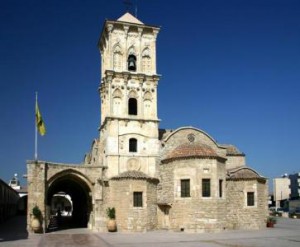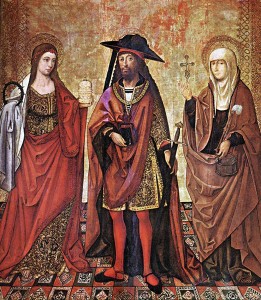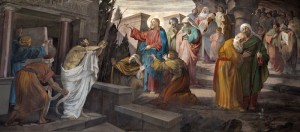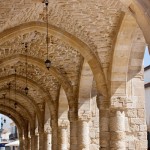Longtime observers of Los Angeles’ social scene will have noticed at various formal events around the city held during the year, the presence on various types of formal wear of a green Maltese cross; ask the wearer what organization it symbolizes, and he will say “the Order of St. Lazarus,” which may not mean much to the questioner. If said observers’ memories go back to the 1970s, they may recall the glittering events put on for the Order by member Hernando Courtright at his Beverly Wilshire Hotel, of else, in the same era the grand ecumenical service on the Order’s behalf at St. Basil’s Church on Wilshire Boulevard. With Archbishop Fulton Sheen as the preacher and Cardinals Manning and McIntyre in attendance, it was a memorable occurrence.
But there is far more to the Order of St. Lazarus than social events and glitterati. The Green Cross of St. Lazarus traces its history back to the Crusades, and its members struggle to answer many needs around the world, but especially those of lepers. Although Catholic in origins, numbering many high ecclesiastics in it membership and having the Melkite Catholic Patriarch of Antioch as its Protector, its ranks are open to Christians of all denominations. The chapels of the Order can be found in both Catholic and non-Catholic churches; and yet — especially as their aid to Eastern Europe has increased, the Order has begun to have a closer relationship with the Papacy. Both its current state and its history have rather mysterious chapters, as we shall see; but what is certain is the amount of good work the Order has done in the past, and is doing now.
As with the Order of Malta, that of St. Lazarus looks to the liberation of Jerusalem by the Crusaders in 1099 as its point of origin. Records are scanty; but it appears that in addition to the Hospital of St. John close by the Holy Sepulchre where the forerunners of the Order of Malta cared for pilgrims and the sick, there was a Domus Leprosorum — a house for lepers — outside the walls of the City. It was near or at the site of today’s St. Louis Hospital, where the Sisters of St. Joseph of the Apparition care for the aged and terminally ill of all religions and races under the protection of the French Government. This Leprosarium was staffed by knights, and was quite likely also under the direction of Bl. Gerard de Toque. So it is that the Order of St. Lazarus, which claims that House of Lepers as its cradles, also claims Bl. Gerard as its founder.
Its first patients were both knights of Godfrey of Bouillon’s army and locals who contracted the dreaded disease. At a time when lepers were treated — well, as lepers — the house, placed under the patronage of St. Lazarus who had also died and risen from the dead (leprosy was considered a sort of living death), the inmates were given a regular spiritual life and the best physical treatment the era could give. As with the Hospital of St. John, it soon attracted the patronage of the Kings of Jerusalem, and houses of the new Order (approved by Pope Paschal II in 1115). Bl. Gerard’s successor at the Hospital of St. John was Bl. Raymond du Puy; at St. Lazarus it was Boyant Roger. But in the early years a close connection was kept with the Knights Hospitallers — Bl. Raymond even serving as Grand Master of St. Lazarus after Boyant’s third successor died.
Inevitably, the need for treatment of leprosy led to the establishment of houses in a number of cities in the Holy Land; the continual warfare which faced the Crusaders in Palestine also forced the Order of St. Lazarus to become military as it had the Hospitallers, the Templars, and the Teutonic Knights. The healthy knights would care for their leper brethren during times of peace, and assist them in battle. The frightening appearance of a charge by the latter could freeze the heart of the bravest Saracen.
As with the other three orders, the need for economic support for the military and medical efforts of the Knights of St. Lazarus led to the establishment of a network of Commanderies throughout Europe, especially in England, France, and Italy. These locales served not only as sources of funding and recruitment, they also provided care for local lepers as well. This was an essential service given the legal isolation sufferers from the disease labored under then. So renowned did the Order become for its medical care that to this day the green cross in its primitive form remains the universal sign of pharmacies in Continental Europe.
The military orders played a key role in the political life of Palestine, or Outremer as the Crusaders called it. After Jerusalem fell to Saladin in 1187, they removed their headquarters to Acre. Knights of St. Lazarus played their part in all the campaigns of the Kingdom of Jerusalem, including the disastrous invasion of Egypt (1248-50). Four years later, the knights petitioned Pope Alexander IV and King St. Louis IX (who had witnessed their bravery first hand in Egypt) for permission to move their own headquarters to the Commandery of Boigny in France (a former royal residence given the Order a century before by Louis VII). This was granted. As a result, when Acre fell at last to the Muslims in 1291, and all its denizens slaughtered — including the St. Lazarus knights present — and the other Order had to reorganize in Cyprus, the Order of St. Lazarus’ smooth functioning was not disrupted. Moreover, where the other Orders had to reconfigure their mission (the Hospitaller to fighting pirates from their new base in Rhodes, the Teutonic Knights to battling pagans in Prussia, and the Templars to administering their lands and eventual bloody dissolution), the Order of St. Lazarus did not. Their array of hospital-commanderies continued to treat lepers as they had always done.
In France, during the Hundred Years war, the French knights fought for their King against the English; in 1443, Polish, Hungarian, and Dalmatian knights accompanied their King in his crusade against the Turks. The main struggle of the Order, however, against leprosy, was quite successful. But as the disease became ever rarer, the need for such an order became less apparent. In 1489, Pope Urban VIII, hoping to beef up the Knights of Rhodes for a new Crusade to free the Holy Land, decreed the suppression of St. Lazarus (as well as the Canons of the Holy Sepulcher); due to the opposition of the King of France, however, this remained a dead letter (not, however, in certain areas, such as in parts of Germany). But the writing was definitely on the wall.
In 1517, by the Pragmatic Sanction of Bourges, the King of France assumed a great deal of control over the administration of the Church in his country — and this included the commanderies of St. Lazarus in his domains. But in the same year, the Pope invited Emperor Charles V to assume control over the Order in Sicily; a new Grand Master was enthroned at Capua in Italy. Nine years later, the Hungarian and many other Central European knights would die with the King of Hungary, Louis II, at the Battle of Mohacs, as the Turks swept over that country. In 1530 Henry VIII would size the properties in England; similar fates awaited most of the houses in Switzerland (although one survived, to become an Abbey of Benedictine nuns in the following century), and northern Germany.
The Italian portion of the Order was merged in 1572 by its Grand Master, the Duke of Savoy, with the Order of St. Maurice which he had founded previously. From then on, the new Order of Ss. Maurice and Lazarus would play an important role of Italian history. Losing its houses outside of the lands of the House of Savoy to various other Italian rulers (the headquarters at Capua would fall to the Bourbons of Naples, and remains today a popular shrine), its member would fight the Barbary pirates for a time on ships of their own. It would go on with its chivalric, Hospitaller, and religious role even after the unification of Italy. When the Italian Monarchy was overthrown in 1946, the Order’s properties — churches and hospitals — continued to be used for their original purposed by a foundation under the Italian government, while the deposed King and his heirs have presented the Order to deserving people ever since.
The three or so houses in Austria were left on their own by these developments, but soldiered on until being suppressed by Joseph II in 1785.
In France, however, the Order of St. Lazarus continued with its headquarters at Boigny, ever increasingly controlled by the French Crown. King Henry IV founded a new military order himself, the Order of Mount Carmel; the following year the Pope gave him permission to merge the houses of St. Lazarus in France with his new foundation. As the 17th century went on, the Grand Masters of the Order of Our Lady of Mount Carmel and St. Lazarus functioned ever more closely under the orders of the King. Under Louis XIV, they fitted out a fleets of ten ships which did sterling work against English and pirate ships in the English Channel; they als opened a naval hospital in St. Malo and two naval officers’ schools. This maritime activity went on until, in 1680, Grand Master Charles Achille Nerestaing, exhausted with naval campaigning, resigned. The knights met at Boigny, resolving to make Louis himself Grand Master, as was the case with Orders under the control of the King of Spain and the Dukes of Tuscany and Savoy. Louis refused the role, but as time went on, the Order came ever closer to the throne. In 1720, the Duke of Orleans was appointed Grand Master, and in 1753 Louis XV conferred this honor on his grandson, the Duke de Berry (the future Louis XVI). During this time, although the Order’s naval schools were closed and replace with Royal one, their connection with the Royal Military College in Paris was cemented. The topmost graduates every year were given knighthood, a much sought after honor.
When the Duke de Berry’s father (son and heir to the still-living Louis XV) died and he succeeded him as Dauphin, he resigned the Grand Mastership which went to his next youngest brother, the Comte de Provence (future Louis XVIII). In 1788, Louis XVI abolished the Military School and gave its Paris buildings to the Order. The next year began the French Revolution. The Grand Master went into exile in Mittau, Russia (now Jelgava, Latvia) while the revolutionary government seized the Order’s property, including the headquarters at Boigny. In his Baltic refuge, the Grand Master created several non-Catholic Knights, including his host Tsar Paul I, who had become the Grand Master of Malta.
When at last peace returned to Europe in 1814, and Louis XVIII was able to return securely to the throne of his fathers, his officially became “Protector” rather than Grand Master of the Order, and honor taken by his brother in 1824, when he in turn inherited the throne as Charles X. Overthrown and sent into exile in 1830, Charles was succeeded as King by his cousin, Louis Philippe of Orleans. The new monarch decreed that the Legion of Honor would be the only Chivalric Order recognized by the Crown.
At this point, the story of the Order of St. Lazarus becomes murky, with various scholars making various claims. The Green Cross knights of today maintain that the survivors of the Order sought and received the protection of the Melkite Catholic Patriarch of Antioch — and certainly, those prelates have played an important role in the life of the Order ever since, regardless of whose theory is accepted. This includes the blessing of the Patriarch upon the formation of a Council to run the Order of St. Lazarus at Paris in 1910. After World War I this body expanded its activities — especially of a medical nature — to Spain and the Netherlands. In 1930, the Council restored to itself the title of Grand Magistery, and were joined by a Spanish Bourbon, Francis, the Duke of Seville.
In view of the close connection before the French Revolution of the House of Bourbon with the Order — and the effect the fractures in that dynasty would have on the Order until today — it is necessary to understand a little bit about those divisions. Louis XIV made his brother the Duke of Orleans — the same brother who would become Grand Master of St. Lazarus in 1720; from him descends the House of Bourbon-Orleans. When the Spanish branch of the House of Habsburg was about to die out, Charles II, the last of that family, made one of Louis’s younger grandsons— the future Philip V of Spain — his heir. The result was the War of the Spanish Succession, after which Philip renounced the throne of France for himself and his heirs by treaty. His first son, Ferdinand VI succeeded him as King of Spain, died childless, and was succeeded by his brother Charles III (who had been Duke of Parma and then King of Naples; after abdicating those realms and ascending the Spanish throne, he would go on to found both Los Angeles and California).
Meanwhile, during the French Revolution, the then Duke of Orleans sided with the revolutionaries, and voted for his cousin Louis XVI’s death, only to be guillotined himself. When the martyred Louis’ brothers returned to the restored Kingdom of France, that Duke’s son was reconciled with them, and returned home also. Emulating his father, however, he sided with the rebels of 1830, and gained the throne for himself. Needless to say this damaged his and his children’s relationship with the main branch of the family. Overthrown in his turn in 1848 Louis Philippe also had to go into exile. But his cousins and their supporters would have nothing to do with him and his heirs; this split in the Royalist Party would last until 1872, when the Orleans princes reconciled with the childless grandson of Charles X, Henry V — called the Comte de Chambord.
When Henry died in 1883, most of his supporters accepted the House of Orleans as his rightful heirs to the throne of France: most, but not all. For ideological and other reason, some looked to the senior line of the Spanish Bourbons, explaining that the renunciation Philip had made back in the 18th century could not abrogate the dynasty’s law of succession. So long the senior Spanish Bourbons were busy with Spain, this meant little, practically. But after the overthrow of Spain’s Alfonso XIII, that King persuaded his blind and deaf elder son, Don Jaime, to give up his rights to the Spanish Crown to his next eldest brother. Jaime did not renounce his rights to France, however; and while his nephew would eventually return to Spain as King Juan Carlos I, his own son and grandson began to press their claims to the throne of France, and in our time have attracted a large following. But the bitterness between the “Orleanists” and the “Legitimists” remains very strong. In recent decades a French court ruled that Louis, Duke of Anjou, great-grandson of Don Jaime is the head of the House of France; recently the Orleans head, Henry, Count of Paris, made his nephew Charles Duke of Anjou as a sort of studied insult to the legitimists. As will be seen this genealogical excursion is necessary to explain the current situation of the Order of St. Lazarus.
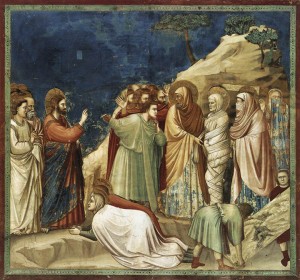
GIOTTO di Bondone, Scenes from the Life of Christ - The Raising of St. Lazarus, 1304-06, Fresco, 200 x 185 cm, Cappella Scrovegni (Arena Chapel), Padua
The election of the Duke of Seville as Grand Master in 1935 was symbolically important, as it meant the revival of the connection of the Order with the House of Bourbon, even by a junior representative. Certainly the organizational and charitable activities of the Order underwent a radical upswing as a result. Not only were national associations established, such as in Bohemia with Prince Charles von Schwarzenberg, Romania with King Carol II, and Bulgaria with King Boris III, but the first Americans joined the Order. Systematic training in first aid began, the result being that, upon the outbreak of World War II the French knights were able to organize an ambulance section for the French Army during the Battle of France. They continued this work under the German Occupation, forming the “Volunteers of the Order of St. Lazarus” to do rescue work among the population during the bombing. The Occupation authorities gave them the grounds of the Military School, and so they were able to control of and preserve the chapel and buildings the Order of St. Lazarus had held so briefly in 1788-89. After the War, the French Government returned the School to the French Army, but the French branch of the Order is justifiably proud of the role they played in preserving this historical corner of Paris.
The end of World War II saw an explosion in the scope of the Order, as commanderies and priories multiplied across the globe. Not only did members support local charities and foreign work, but Knights of St. Lazarus took the lead in various places in setting up relief agencies. Especially important was the role the Order began to play in the fight against leprosy in the various places where it survives. Given the presence of Protestants and Orthodox in their ranks, the Order also began to feature Christian Ecumenism prominently in its work. Chapels of St. Lazarus of various denominations were opened. To mention only one typical work, the Knights assisted in the opening of a major dispensary in Lebanon in 1963. To the Order’s great joy, four years later they were able to secure ownership of the original house at Boigny. The same year, a Bourbon-Orleans Prince, the Duke of Nemours, succeeded the retiring Duke of Seville as Grand Master
But two years later, this triumph was undercut by a disaster; a dispute between the Grand Master and the administration in Paris led to a rift between the two; the latter declared the Duke deposed, and replaced him with the Duke of Brissac — of an ancient noble, but not royal, French family. Then began along and complicated series of rifts between the supporters of the two sides. All during this era, however, local branches continued to expand their work of relieving the suffering — and, indeed, such local groups as well as the Patriarch of Antioch, mindful of his role as Spiritual Protector — sought reunion. In the meantime, the Austrian Order was given official recognition under canon law by the bishops of that country, and numbered several members of the Habsburg clan in their leadership. At last, the Archduke Otto von Habsburg, son and heir of Bl. Charles of Austria, last reigning Emperor of that country and King of Hungary, took on the position of High Protector of the Order in Austria, a role he maintains today.
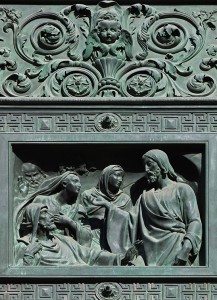
The Raising of Lazarus, relief of the caisson top of the Western front doors of the Isaak Cathedral, St. Petersburg
The fall of the Iron Curtain meant not only the opening up of the Eastern bloc, but the revelation of just how much misery and poverty was to be found there. Millions of dollars in aid was raised and distributed by various branches of the Order, earning its members not only the cooperation of the European Union and accolades not only by the governments of Hungary, Croatia, Romania and elsewhere, but personal approbation by Bl. John Paul II. Pressure to reunite the Order in the wake of this success became ever greater.
In 2008, unity of most of the two branches was attained, with anther Spanish Bourbon, Carlos Gererda de Borbon, Marquis de Almazan, as Grand Master, with headquarters in Malta. But another schism had already developed four years earlier as result. Its members sought the protection of Henry, Count of Paris, head of the Bourbon-Orleans, and elected his nephew, Charles Phlippe — the Orleanist Duke of Anjou — whom we noticed earlier. Although he resigned a few years later in favor of his maternal uncle, Count Jan Dobrzenský z Dobrzenicz, the Count of Paris continues as protector, and this is seen as a return to the royal patronage of France — which is of course only accepted by those who prefer the Orleans claims over those of Louis, Duke of Anjou. In place of the Patriarch of Antioch, the Orleans obedience has taken Cardinal Paskai, retired Primate of Hungary, as its protector. The Order of St. Lazarus under the Marquis de Almazan is the only one represented here in Los Angeles, and by far the larger of the two.
Despite all of this, both branches of the Order of St. Lazarus maintain an impressive array of relief and medical works, and the outsider can only hope that their internal problems are speedily resolved, as they have been in different ways and at different times by such orders as the Carmelites, Franciscans, and the Sovereign Order of Malta. For the Catholic, although the Order will not gain Papal legal recognition alongside Malta, the Holy Sepulcher, and the Teutonic Order, the protection of the Melkite Patriarch, the current membership in the Malta Obedience of such prelates as Australia’s Cardinal Pell, and the participation of the Archduke Otto speaks highly for it in the here and now, whatever the Order’s internal stresses, and the issues raised by various legal and historical writers. Looking beyond those immediate issues, one can only applaud its success in bringing the spirit of chivalry to bear on the problems of the modern world.
The following links are presented in terms of their informative value, especially as regards the current work of the Order and their illustrious past. Inclusion should not be seen as either approval or condemnation by the Queen of Angels of the views expressed therein. Sites favoring the Malta Obedience will be followed with (M); those of Orleans shall have (O). Similarly, the first two articles cited in the historical section are critical of the historical claims of the Order; the third takes a more nuanced, sympathetic view. All three authors are renowned for their expertise in this field, and the Queen of Angels Foundation offers no opinion regarding their views.
HISTORICAL
“The Order of St. Lazarus” by Guy Stair Sainty
http://www.chivalricorders.org/orders/self-styled/lazarus.htm
“Revived Orders of Chivalry:” The Case of the Order of St. Lazarus by Francois Velde
http://www.heraldica.org/topics/orders/lazarus.htm
Military and Hospitaller Order of St. Lazarus of Jerusalem by Peter Bander Van Duren
http://www.stelling.nl/vrijmetselarij/ridders/lazarus_bander.html
The Domus Leprosarium in Crusader Jerusalem by C. Savona-Ventura
http://www.van-oppen.org/domus_leprosorum_in_crusader_jer.htm
The Order of St. Lazarus in the Latin East byNatalie Kohout
http://www.militaryhistoryonline.com/crusades/articles/stlazarus.aspx
INTERNATIONAL
Military and Hospitaller Order of St. Lazarus of Jerusalem (M)
http://www.st-lazarus.net/
Melkite Patriarch of Antioch (M)
http://www.mliles.com/melkite/orderstlazarus.shtml
George Cardinal Pell, Archbishop of Sydney (M)
http://www.sydney.catholic.org.au/people/archbishop/biography.shtml
Military and Hospitaller Order of St. Lazarus of Jerusalem (O)
http://www.oslj.org/
St. Lazare Foundation (O)
http://www.oslj.org/Foundation/
Tomas Cardinal Paskai, Primate Emeritus of Hungary (O)
http://franka-egom.ofm.hu/irattar/szent_lazar_uw_hu_2009/kozgyules_kepei/velence.htm
EUROPE
AUSTRIA
Order of St. Lazarus in Austria (M)
http://www.lazarus-orden.eu/
HIRH Otto von Habsburg, High Protector of the Order of St. Lazarus in Austria (M)
http://otto.twschwarzer.de/
Grand Bailiwick of the Order of St. Lazarus in Austria (M)
http://www.lazarus-orden.eu/page0/page0.html
Grand Priory of the Order of St. Lazarus in Austria (M)
http://www.lazarus-orden.at/
Church of the Nativity of Mary, Vienna (M)
http://www.lazarus-orden.at/go_ordenskirche.htm
http://www.pfarremariageburt-rennweg.at/
Lazarus Aid in Austria (M)
http://www.lhw-salzburg.at/
Lazarus Club, Vienna (M)
http://www.lazarusclub.at/
CZECH REPUBLIC
Grand Priory of the Order of St. Lazarus in the Czech Republic (M)
http://www.st-lazarus.cz/
Atavis et Armis (M)
http://www.atavis-et-armis.info/military_and_hospitaller_order_of_saint_lazarus_of_jerusalem_en.html
Radimovice Manor (M)
http://www.atavis-et-armis.info/radimovice_manor_en.html
Hospice of St. Lazarus in Plzen (M)
http://www.hsl.cz/cs/index.php?stranka=1&podstranka=0
Grand Priory of the Order of St. Lazarus in Bohemia (O)
http://www.oslj.cz/
FRANCE
Grand Priory of the Order of St. Lazarus in France (M)
http://www.chevaliers-saint-lazare.org/
Magistral Seat of Boigny (M)
http://www.chevaliers-saint-lazare.org/boigny—siege-magistral.html
Grand Bailiwick of Boigny (M)
http://www.oslj-boigny.fr/
St. Louis Chapel of the Military School, Paris
http://www.aumonerie-ecole-militaire.fr/chapelle/
GERMANY
Union of the Order of St. Lazarus in Germany (M)
http://www.lazarus-in-deutschland.de/
Grand Bailiwick of the Order of St. Lazarus in Germany (M)
http://www.st-lazarus-orden.de/
Grand Priory of the Order of St. Lazarus in Germany (M)
http://dlhg.de/index2.html
German Lazarus Foundation (M)
http://www.deutsche-lazarus-stiftung.de/
Lazarus Aid in Germany (M)
http://www.lazarus.de/
Hereditary Commandery of Villa Wallendorf of the Order of St. Lazarus (M)
http://www.mhoslj.de
Schloss Johannisberg, Geisenheim
http://www.schloss-johannisberg.de/en/index.htm
Maria Magdalena Hospital, Gotha
http://www.kultourstadt.de/index.php?id=1058
Priory of the Knights of St. Lazarus in the Archdiocese of Freiburg
http://www.lazarus-orden.org/
Volunteer Corps of the Order of St. Lazarus in Germany
http://www.hilfskorps.de/
GREAT BRITAIN
Grand Priory and Bailiwick of the Order of St. Lazarus in England and Wales (M)
http://www.st-lazarus.org.uk/
Hospital of St. Lazarus, Burton Lazars, Leicestershire
http://www.british-history.ac.uk/report.aspx?compid=38173
Grand Bailiwick of Scotland (M)
http://www.lazarus-scotland.co.uk/
St. Vincent’s Scottish Episcopal Church, Edinburgh
http://www.sacredscotland.org.uk/church/st-vincents-church-edinburgh
GREECE
Grand Priory of the Order of St. Lazarus in Greece (M)
http://www.saint-lazarus-hellas.gr/Default.aspx
HUNGARY
Order of St. Lazarus in Hungary (M)
http://www.saint-lazarus.org/
IRELAND
Grand Priory of the Order of St. Lazarus in Ireland M)
http://www.stlazarus.ie/St.Lazarus_Ireland/Home.html
Chapel of St. Stephen, St. Patrick’s Cathedral, Dublin (M)
http://www.stlazarus.ie/St.Lazarus_Ireland/Chapel.html
St. Patrick’s Cathedral, Dublin
http://en.wikipedia.org/wiki/St_Patrick’s_Cathedral,_Dublin
Hereditary Commandery of Fanad (M)
http://www.st-lazarus.net/fanad-m/frame.htm
ITALY
Order of Ss. Maurice and Lazarus by Guy Stair Sainty
http://www.chivalricorders.org/orders/italian/maurice.htm
Religious and Military Order of Ss. Maurice and Lazarus
http://www.ordinidinasticicasasavoia.it/?cat=2
Hospital Administration of the Order of St. Maurice
http://www.mauriziano.it/flex/cm/pages/ServeBLOB.php/L/IT/IDPagina/1
Patrimony of the Order of St. Maurice
http://ww2.mauriziano.it/arte/frsetpatr.htm
Friends of the Foundation of St. Maurice
http://www.amicibbaamauriziano.it/
Shrine of St. Lazarus, Capua
http://www.cittadicapua.it/chiese/chiesalazzaro.htm
LIECHTENSTEIN
Grand Priory of the St. Lazarus in Liechtenstein (M)
http://www.lazarus.li/
Lazarus Aid in Liechtenstein (M)
http://www.lhw-li.org/
LUXEMBOURG
Foundation of the Order of St. Lazarus in Luxembourg (M)
http://www.st-lazarus.net/lux-found/frame.htm
MALTA
Grand Commandery of the Castello (M)
http://www.stlazarus-mt.org/
Grand Priory of the Order of St. Lazarus in the Maltese Islands (M)
http://www.stlazarusmalta.org/
The Castello, Malta (M)
http://www.stlazarus-mt.org/index.php?s=content&p=thecastello
NETHERLANDS
Grand Bailiwick of the Order of St. Lazarus in the Netherlands
http://www.st-lazarus.nl/index_bestanden/Page318.html
POLAND
Chapter of the Order of St. Lazarus in Poland (M)
http://lazarus.pl/strona-glowna/
Spiritual Prior of the Grand Bailiwick of Poland (M)
http://www.st-lazarus-orden.pl/
SLOVAKIA
Grand Priory of the Order of St. Lazarus in Slovakia (M)
http://www.oslj.sk/
SPAIN
Grand Priory of Spain (M)
http://www.hermandadsalud.eu/orden-de-san-lazaro.html
International Academy of Our Lady of Mount Carmel (M)
http://www.st-lazarus.net/academy/index.htm
SWITZERLAND
Grand Priory of the Order of St. Lazarus in Switzerland (O)
http://www.oslj.ch/
Lazarus Cavalry Regiment (O)
http://www.lrr.ch/
Monastery of Seedorf
http://www.kloster-seedorf.ch/
St. Lazarus Church, Gfenn in Duebendorf
http://www.duebendorf.ch/de/vereine/kirchenmain/kirchenlazariter/
http://www.duebendorf.ch/de/vereine/tourismus/sehenswuerdigkeiten/welcome.php?action=showobject&object_id=749
St. Michael’s Church, Meiringen
http://www.refkgm.ch/geschichte/geschichte.php
OCEANIA
AUSTRALIA
Grand Priory of the Order of St. Lazarus in Australia (M)
http://www.st-lazarus.org.au/
St. John’s Anglican Church, Gordon, Sydney (M)
http://www.stjohnsgordon.org.au/
THE AMERICAS
BRAZIL
Grand Priory of the Order of St. Lazarus in Brazil (M)
http://www.stlazarusbrasil.org/
CANADA
Grand Priory of the Order of St. Lazarus in the United States (M)
http://www.stlazarus.ca/english/homeeng.html
St. Andrew’s Presbyterian Church, Toronto
http://www.standrewstoronto.org/
MEXICO
Delegation of the Order of St. Lazarus in Mexico (M)
http://mexico.st-lazarus.us/
Order of St. Lazarus in Mexico (M)
http://www.sanlazaromexico.org/Informacion_General.html
UNITED STATES
Grand Priory of the Order of St. Lazarus in the United States (M)
http://www.st-lazarus.us/
National Shrine of the Order of St. Lazarus, New Orleans (M)
http://www.st-lazarus.us/index.html?http://www.st-lazarus.us/national-shrine.html
Delegation of the Savoy Orders in the United States
http://www.savoydelegation-usa.org/
